
Under the Whyte notation for the classification of steam locomotives, 2-6-0 represents the wheel arrangement of two leading wheels on one axle, usually in a leading truck, six powered and coupled driving wheels on three axles and no trailing wheels. This arrangement is commonly called a Mogul.

Under the Whyte notation for the classification of steam locomotives, 2-8-2 represents the wheel arrangement of two leading wheels on one axle, usually in a leading truck, eight powered and coupled driving wheels on four axles and two trailing wheels on one axle, usually in a trailing truck. This configuration of steam locomotive is most often referred to as a Mikado, frequently shortened to Mike.

The B&O Railroad Museum is a museum and historic railway station exhibiting historic railroad equipment in Baltimore, Maryland. The Baltimore and Ohio Railroad (B&O) company originally opened the museum on July 4, 1953, with the name of the Baltimore & Ohio Transportation Museum. It has been called one of the most significant collections of railroad treasures in the world and has the largest collection of 19th-century locomotives in the U.S. The museum is located in the Baltimore and Ohio Railroad's old Mount Clare Station and adjacent roundhouse, and retains 40 acres of the B&O's sprawling Mount Clare Shops site, which is where, in 1829, the B&O began America's first railroad and is the oldest railroad manufacturing complex in the United States.
Under the Whyte notation for the classification of steam locomotives, 0-8-0 represents the wheel arrangement of no leading wheels, eight powered and coupled driving wheels on four axles and no trailing wheels. Locomotives of this type are also referred to as eight coupled.

The St. Louis–San Francisco Railway, commonly known as the "Frisco", was a railroad that operated in the Midwest and South Central United States from 1876 to April 17, 1980. At the end of 1970, it operated 4,547 miles (7,318 km) of road on 6,574 miles (10,580 km) of track, not including subsidiaries Quanah, Acme and Pacific Railway and the Alabama, Tennessee and Northern Railroad; that year, it reported 12,795 million ton-miles of revenue freight and no passengers. It was purchased and absorbed into the Burlington Northern Railroad in 1980. Despite its name, it never came close to San Francisco.
Under the Whyte notation for the classification of steam locomotives by wheel arrangement, a 2-6-6-2 is a locomotive with one pair of unpowered leading wheels, followed by two sets of three pairs of powered driving wheels and one pair of trailing wheels. The wheel arrangement was principally used on Mallet-type articulated locomotives, although some tank locomotive examples were also built. A Garratt locomotive or Golwé locomotive with the same wheel arrangement is designated 2-6-0+0-6-2 since both engine units are pivoting.
The Wilmington and Western Railroad is a freight and heritage railroad in northern Delaware, operating over a former Baltimore and Ohio Railroad (B&O) branch line between Wilmington and Hockessin. The 10.2-mile (16.4 km) railroad operates both steam and diesel locomotives. It was added to the National Register of Historic Places as a national historic district in 1980. Wilmington & Western serves one customer for revenue service, and interchanges with CSX Transportation at Landenberg Junction, Delaware

The USRA Light Mikado was a USRA standard class of steam locomotive designed under the control of the United States Railroad Administration, the nationalized railroad system in the United States during World War I. This was the standard light freight locomotive of the USRA types, and was of 2-8-2 wheel arrangement in the Whyte notation, or 1′D1′ in UIC classification.
On the Baltimore and Ohio Railroad, locomotives were always considered of great importance, and the railroad was involved in many experiments and innovations.

Pennsylvania Railroad Class L1s were 2-8-2 "Mikado"-type steam locomotives that were used on the Pennsylvania Railroad during the early twentieth century. These 574 locomotives were manufactured between 1914 and 1919 by the railroad's own Juniata Shops as well as the Baldwin Locomotive Works (205) and the Lima Locomotive Works (25).

Oakland station is a historic railroad station located at Oakland, Garrett County, Maryland. It is a large brick structure with a two-story central section featuring a cylindrical tower with a domed cap and one-story wings extending from each end along the railroad tracks. It was designed by Baldwin and Pennington, and built in 1884 by the Baltimore and Ohio Railroad (B&O) across the tracks and a meadow from the Railroad's Oakland Hotel, which opened in 1876, to support the development of Oakland and Garrett County as a resort area. It is one of the finest remaining examples in Maryland of a Queen Anne style railroad station.

The USRA Light Pacific was a USRA standard class of steam locomotive designed under the control of the United States Railroad Administration, the nationalized railroad system in the United States during World War I. It was the standard light passenger locomotive of the USRA types, with a 4-6-2 wheel arrangement in the Whyte notation, or 2′C1′ in UIC classification.

Maine Central Railroad Class S locomotives were intended for heavy freight service. They were of 2-8-2 wheel arrangement in the Whyte notation, or " 1'D1' " in UIC classification. They replaced earlier class W 2-8-0 locomotives beginning in 1914. They were the largest and most modern steam freight locomotives built for Maine Central; although former Boston and Maine Railroad 2-10-2s were later purchased to handle World War II freight traffic. Class S locomotives pulled freight trains over the main line between Portland and Bangor, Maine; and are best remembered for service on the Mountain Division from 1929, when the class X Mallet locomotives were scrapped, until replacement by diesel locomotives in the early 1950s.

Grand Trunk Western No. 4070 is an S-3-a class 2-8-2 USRA Light Mikado steam locomotive, and it was originally built by the American Locomotive Company (ALCO) in December 1918 for the Grand Trunk Railway (GTR) as No. 474. It was later re-numbered to 3734 by the Grand Trunk Western (GTW), after the GTR was absorbed into Canadian National (CN). In the late 1950s, the locomotive received a larger tender from an S-3-c class locomotive, and it was further re-numbered to 4070.

The Baltimore and Ohio’s P-7 class was a class of 20 Pacific type locomotives built in 1927. Named for the first 20 Presidents of the United States, they were the prime motive power for the B&O’s top passenger trains for 31 years. One example, Baltimore and Ohio 5300, the "President Washington", has been preserved.

Atlantic Coast Line 1504 is a 4-6-2 steam locomotive built in March 1919 by the American Locomotive Company (ALCO) of Richmond, Virginia, for the Atlantic Coast Line Railroad (ACL) as a member of the P-5-A class under the United States Railroad Administration (USRA) standard. No. 1504 was assigned to pull ACL's premier main line passenger trains during the 1920s to early 40s and even main line freight trains in the late 1940s until it was retired from revenue service at the end of 1952.

Spokane, Portland and Seattle Railway No. 539 is the only preserved example of the class O-3 2-8-2 "Mikado" steam locomotive. It was built by the American Locomotive Company in 1917 for the Northern Pacific Railway as engine No. 1762. It was sold to the Spokane, Portland and Seattle Railway and renumbered 539, in August 1944. It was reconfigured and converted to oil burning in January 1946. The locomotive was retired in 1957, and it was displayed in Esther Short Park, Washington, until 1997. That year, it was moved to Battle Ground for a potential restoration that never came to fruition. In 2007, it was acquired by the Grand Canyon Railway and moved to Williams, Arizona for an operational restoration that also never came to fruition. In 2019, No. 539 was purchased again by the Port of Kalama, who moved it back to Washington and put it on static display inside the Port's Interpretive Center that was constructed in 2014.
Baltimore and Ohio No. 5300, also known as President Washington, is the sole survivor of the P-7 class 4-6-2 "Pacific" type steam locomotives. It was built by Baldwin in 1927, and it was used on mainline passenger trains across the Baltimore and Ohio system, particularly the Royal Blue train, until it was retired in 1957. After being stored for a few years, it was donated to the Baltimore and Ohio Railroad Museum in Baltimore, Maryland, where it has spent several years on static display. The locomotive is undergoing a cosmetic restoration, as of 2023.

Chesapeake and Ohio No. 490 is the sole survivor of the L-1 class 4-6-4 "Hudson" type steam locomotives. It was built by Alco's Richmond works in 1926 as an F-19 class 4-6-2 "Pacific" type to be used to pull the Chesapeake and Ohio's secondary passenger trains. It was eventually rebuilt in 1947 to become a streamlined 4-6-4 for the C&O's Chessie streamliner. After the Chessie was cancelled, No. 490 remained in secondary passenger service, until it was retired in 1953. It spent several years in storage in Huntington, West Virginia, until 1968, when it was donated to the B&O Railroad Museum in Baltimore, Maryland. It remains on static display at the museum, as of 2023.
Chicago, Burlington and Quincy 4963 is a preserved class "O-1a" 2-8-2 "Mikado" type steam locomotive originally built by the Baldwin Locomotive Works in 1923 for the Chicago, Burlington and Quincy Railroad. It was used by the CB&Q to haul mainline freight trains before it was leased to the Bevier and Southern Railroad to haul short-distance freight trains in the early 1960s. It was subsequently retained by the CB&Q and used as a source of spare parts before being acquired by Richard Jensen.













